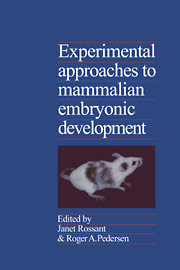Book contents
- Frontmatter
- Contents
- Preface
- Contributors
- Cellular aspects
- 1 Potency, lineage, and allocation in preimplantation mouse embryos
- 2 Time and space in the mouse early embryo: a cell biological approach to cell diversification
- 3 Comparative aspects of embryo manipulation in mammals
- 4 Development of extraembryonic cell lineages in the mouse embryo
- 5 Analysis of tissue fate and prospective potency in the egg cylinder
- Molecular and biochemical aspects
- Toward a genetic understanding of development
- Index
2 - Time and space in the mouse early embryo: a cell biological approach to cell diversification
from Cellular aspects
Published online by Cambridge University Press: 31 March 2010
- Frontmatter
- Contents
- Preface
- Contributors
- Cellular aspects
- 1 Potency, lineage, and allocation in preimplantation mouse embryos
- 2 Time and space in the mouse early embryo: a cell biological approach to cell diversification
- 3 Comparative aspects of embryo manipulation in mammals
- 4 Development of extraembryonic cell lineages in the mouse embryo
- 5 Analysis of tissue fate and prospective potency in the egg cylinder
- Molecular and biochemical aspects
- Toward a genetic understanding of development
- Index
Summary
Introduction
The study of developmental biology seeks to explain how a diversity of cell types arises from a single fertilized egg and does so in the appropriate sequence yielding appropriate spatial relationships. Traditionally, developmental studies have concentrated on two aspects of this problem. A molecular approach has sought to understand how similar complements of genes in all the diverse cell types of the body are regulated and expressed differentially. Active genes, or their flanking sequences, have been analyzed for evidence of physical rearrangement or chemical change, and conclusions have then been drawn concerning the possible nature of the developmental decision-making process. In contrast, the experimental embryological approach to development has followed the subsequent fate of progeny by marking cells in the early embryo, thus building up a descriptive picture of the paths by which cell diversification occurs. This latter approach, when used in conjunction with spatial relocation of cells, has also yielded information on the plasticity of development. As a result, hypotheses have been formulated in which the relative importance for development of a cell's recent history versus its current positional relationships can be evaluated. There is, however, a considerable gulf between molecular analysis of gene expression and description and categorization of developmental pathways. Between lies the cell biology of development: how cells move, measure the passage of time, and recognize relative position. This chapter represents an attempt to interpret the developmental biology of the early mammalian embryo in terms of cell biological mechanisms and thus to focus the questions of molecular control more precisely.
- Type
- Chapter
- Information
- Publisher: Cambridge University PressPrint publication year: 1987
- 3
- Cited by



